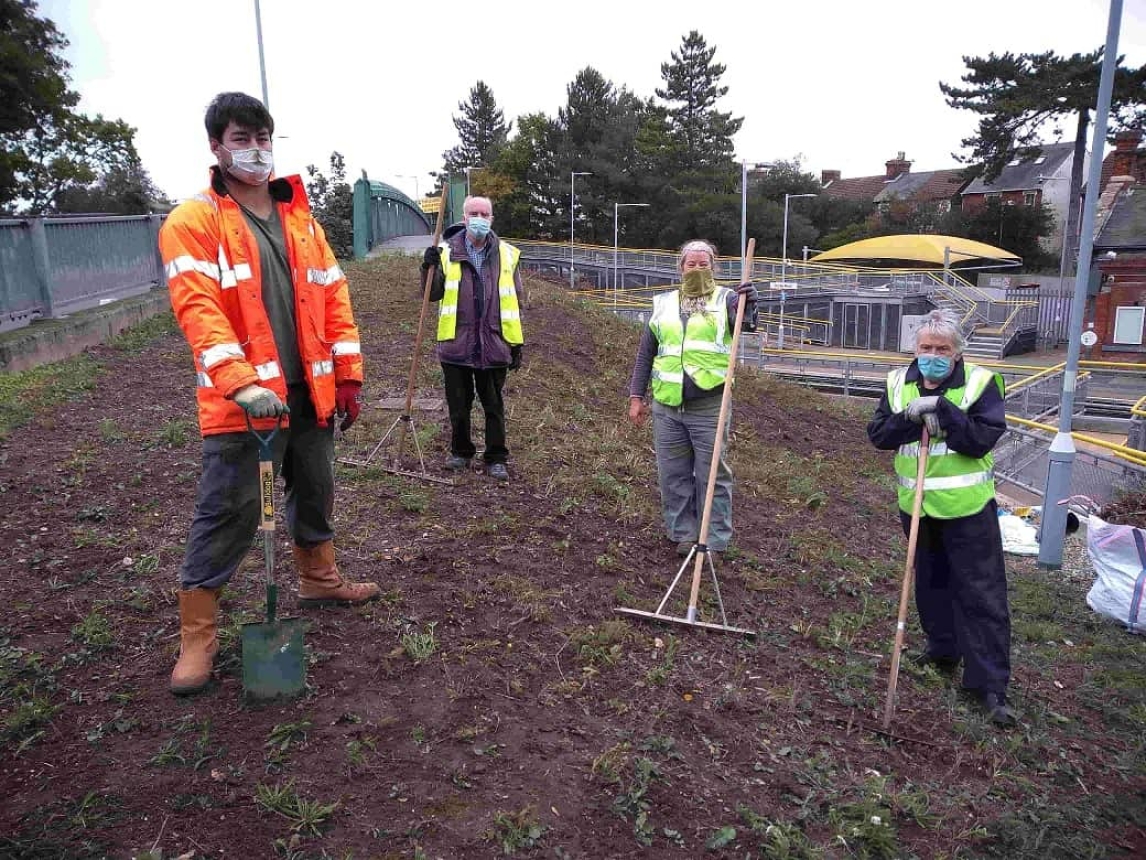Published on: Friday, 2 October 2020
Last updated: Friday, 2 October 2020
A partnership between local people and the railway has seen a large area of land at Derby Road rail station transformed into a ‘pollinator patch’ to support wildlife.
Volunteer station adopters worked with the East Suffolk Lines Community Rail Partnership, Greater Anglia, Ipswich Friends of the Earth and Ipswich Wildlife Rangers to plant thousands of wildflower seeds on 26 September 2020.
The team of five volunteers spent the day clearing and scarifying the ground with rakes before planting a mixture of seed containing 21 native wildflower species such as poppy, cornflower and corn cockle, as well as many perennials.
Once the plants are established, the area – which is next to the road at the entrance to the station -will become a haven for bees, butterflies, beetles and other pollinating insects, as well as an attractive, welcoming display for people who use the station.
Claire Kendall, East Suffolk Lines Community Rail Officer, said, “It was tough work preparing and sowing the area, but very enjoyable to work together on this. It was extremely rewarding and we are all looking forward to seeing the wildflowers emerge in the spring and observing the wildlife it will attract.
“We are really hoping that the new area will even attract East Anglia’s own local and endangered stag beetles to visit.
“This is the start of a great partnership between us all. We hope to continue to work together on future local projects through the friendships and connections made. It has been a great partnership project which benefits the whole community through supporting our local wildlife and also providing an attractive display of which we can all be proud.”
Emma Black of Ipswich Friends of the Earth, commented: “Ipswich Friends of the Earth actively support projects that improve Ipswich's environment for wildlife and people. We're delighted to be involved in this wildlife project as it will increase the biodiversity in the local area and bring people closer to nature. Working in partnership enables us to achieve a better environment for Ipswich.”
Greater Anglia’s Customer and Community Engagement Manager, Alan Neville, said: “Wildlife friendly projects at stations like this are helping the railway in East Anglia to lead the green revolution by being a much greener way to travel - and our new fleet of trains will contribute even more thanks to their more environmentally friendly features which reduce CO2 and particulate emissions in the region further still.”
“We are very grateful to everyone involved in this project and look forward to seeing the results as the partnership pollinator patch develops.”
Across Greater Anglia’s network the operator is working with its station adoption volunteers to make rail stations more wildlife friendly – with the railway increasingly being recognised by ecologists as a ‘green corridor’ which provides a sanctuary for many different kinds of flora and fauna.
Many station adopters have planted gardens which provide habitats for local wildlife as well as making the stations more welcoming. In total over 5700 square metres of gardens will be tended to this year – the equivalent of 29 tennis courts.
In a recent survey, the station adopters reported a wide range of creatures visiting their stations including many different types of butterflies as well as bees, slow worms, bats, foxes, hedgehogs, deer and many varieties of birds.



